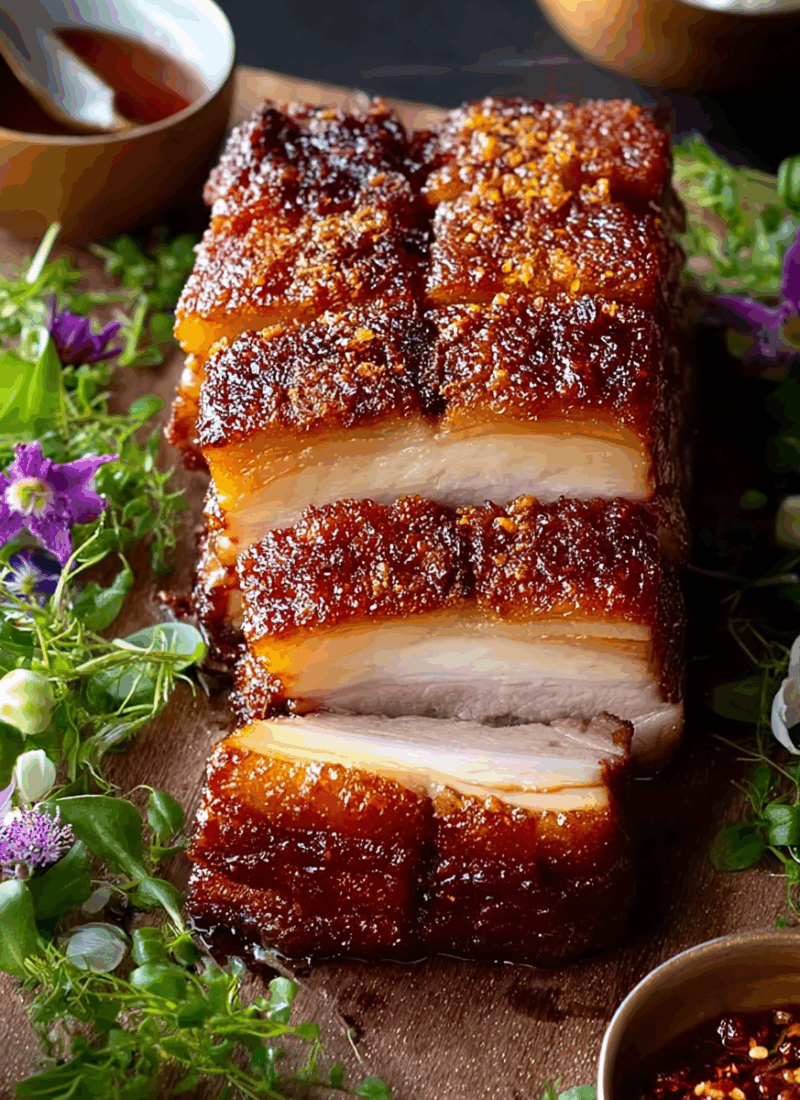Crispy slow-roasted pork belly is the ultimate indulgence for pork lovers, offering a perfect balance between juicy, tender meat and golden, crunchy crackling. Slow cooking ensures the meat stays moist and flavorful, while the high heat at the end creates the irresistible crackling. This dish is ideal for special occasions or a weekend roast, and pairs beautifully with roasted vegetables, mashed potatoes, or a fresh salad.
Full Recipe:
Ingredients
-
1.5 kg (3 lb) pork belly, skin on
-
1 tablespoon olive oil
-
2 teaspoons salt (preferably sea salt flakes)
-
1 tablespoon white vinegar
-
Freshly ground black pepper
-
1 tablespoon Chinese five-spice powder (optional)
Directions
-
Preheat your oven to 150°C (300°F).
-
Pat the pork belly dry, especially the skin, using paper towels.
-
Use a sharp knife to score the pork skin, making incisions about 1 cm apart, cutting through the skin but not into the meat.
-
Rub the pork belly with olive oil, followed by salt, black pepper, and optional Chinese five-spice powder on the meat side.
-
Place the pork belly skin-side up on a rack over a roasting pan. Pour 1 cup of water into the pan to keep the meat moist.
-
Roast the pork in the preheated oven for 2.5 hours.
-
After slow roasting, increase the oven temperature to 240°C (465°F) and roast for an additional 30-40 minutes until the skin is golden and crispy. If necessary, turn on the grill for a few minutes to achieve the perfect crackling.
-
Let the pork rest for 10 minutes before slicing and serving.
Estimated Nutritional Value (Per Serving)
-
Calories: 500 kcal
-
Protein: 35g
-
Fat: 40g
-
Saturated Fat: 13g
-
Monounsaturated Fat: 18g
-
Polyunsaturated Fat: 3g
-
-
Carbohydrates: 1g
-
Fiber: 0g
-
Sugar: 0g
-
-
Cholesterol: 85mg
-
Sodium: 800mg
-
Potassium: 350mg
-
Vitamin A: 80 IU
-
Vitamin C: 0mg
-
Calcium: 15mg
-
Iron: 1.5mg
Note: The values are approximate and can vary based on specific brands of ingredients used and the exact portion sizes.\
Why Choose Pork Belly?
Pork belly is a cut of meat that combines both fat and muscle, making it a perfect choice for slow roasting. The high-fat content ensures that the meat remains juicy and tender, even after hours of slow cooking. Pork belly is also known for its rich flavor, which comes from both the fat and the meat itself. It’s this combination of textures and flavors that make pork belly such a beloved dish for many.
The crispy crackling that forms on the skin is another hallmark of this dish. When roasted at a high temperature, the skin turns golden and crunchy, creating a contrast with the tender, juicy meat. This contrast between textures is part of what makes pork belly so indulgent and satisfying.
The Magic of Slow Roasting
Slow roasting is key to achieving the ideal pork belly. By cooking the pork at a low temperature for an extended period of time (around 2.5 hours), the fat within the pork belly breaks down, allowing the meat to remain moist and tender. During this time, the connective tissues in the meat also break down, resulting in a melt-in-your-mouth experience when you bite into it.
The slow cooking process also allows the flavors to deepen, making the meat incredibly flavorful. The rub made with olive oil, salt, black pepper, and optional Chinese five-spice powder infuses the meat with a savory, slightly aromatic taste, complementing the natural flavors of the pork.
Achieving the Perfect Crackling
The crackling is perhaps the most coveted part of slow-roasted pork belly, and getting it just right requires a high-heat finish. Once the pork has been slow-cooked to perfection, the oven temperature is increased to 240°C (465°F) to crisp up the skin. This step is essential for achieving the golden, crispy crackling that gives the dish its signature texture.
If you’re finding that the skin isn’t crisping up as expected, a few minutes under the grill (broiler) can help achieve the perfect crackling. It’s important to keep an eye on the pork during this step to ensure the skin doesn’t burn, as it can go from golden to overly charred quickly under high heat.
Flavor Variations and Customizations
While the basic recipe calls for a simple rub of olive oil, salt, and black pepper, there’s plenty of room to customize the flavor profile of your slow-roasted pork belly.
-
Chinese Five-Spice Powder: This aromatic spice mix, which includes star anise, cloves, cinnamon, fennel seeds, and Sichuan peppercorns, is a wonderful addition if you’re looking for a more complex, slightly sweet and spicy flavor. The five-spice powder pairs beautifully with the richness of the pork.
-
Herbs and Spices: If you’re not a fan of Chinese five-spice powder, you can experiment with other herbs and spices such as rosemary, thyme, or garlic. These additions can infuse the pork belly with an herbaceous aroma and add layers of flavor.
-
Marinades and Glazes: You could also marinate the pork belly overnight in a mixture of soy sauce, honey, and ginger for an Asian-inspired glaze. For a more tangy variation, a balsamic vinegar glaze would complement the pork’s richness with a slightly acidic contrast.
-
Citrus Zest: Adding citrus zest (such as lemon, orange, or lime) to the rub can brighten the flavor and provide a refreshing contrast to the richness of the pork.
Serving Suggestions and Pairing Ideas
Crispy slow-roasted pork belly is incredibly versatile when it comes to side dishes and pairings. Here are a few ideas to help you create a complete and satisfying meal:
-
Roasted Vegetables: Roasted root vegetables such as carrots, parsnips, or sweet potatoes pair wonderfully with pork belly. The sweetness of the vegetables complements the savory, rich flavor of the pork, creating a harmonious balance of flavors.
-
Mashed Potatoes: Creamy mashed potatoes are another classic pairing with pork belly. The smooth texture of the potatoes acts as a perfect base for the juicy pork, and they absorb the delicious juices from the meat.
-
Salads: A light, crisp salad can provide a refreshing contrast to the richness of the pork belly. Try a simple green salad with arugula, fennel, and a tangy vinaigrette for a bright, fresh accompaniment.
-
Apple Sauce or Chutney: The sweetness of apple sauce or chutney pairs excellently with pork, balancing out the savory flavors. The fruity acidity complements the richness of the slow-roasted pork belly, adding depth to the meal.
-
Rice: For a more filling meal, serve the pork belly with rice or a rice pilaf. The rice will absorb the delicious juices from the meat and make for a comforting, hearty dish.
Tips for Success
-
Scoring the Skin: Make sure to score the skin of the pork belly deeply, but without cutting into the meat. This allows the fat to render out properly and helps the skin crisp up into that beautiful crackling.
-
Pat Dry: Patting the skin of the pork belly dry before roasting is essential for achieving the perfect crackling. Moisture on the skin can prevent it from becoming crispy, so make sure to dry it thoroughly with paper towels before cooking.
-
Resting the Meat: After roasting, let the pork belly rest for about 10 minutes before slicing. This allows the juices to redistribute and ensures the meat stays juicy when served.
Conclusion: A Perfect Roast for Special Occasions
Crispy slow-roasted pork belly is a show-stopping dish that combines rich, tender meat with the irresistible crunch of crackling. Whether you’re preparing it for a special celebration, a family dinner, or simply to indulge in a comforting meal, this recipe is guaranteed to impress. The slow cooking process ensures that the pork remains moist and flavorful, while the high heat at the end creates the perfect golden crackling. With endless possibilities for customization, this dish can easily be adapted to suit your taste preferences, making it a versatile and delicious option for any occasion.








